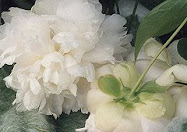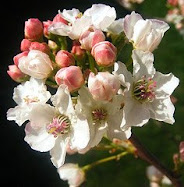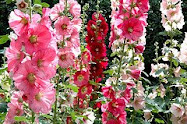 This is the summer of the large, completely smitten crush on daylillies. While always appreciated as reliable, hard-working border dwellers, this year they've knocked my socks off and given me new, heightened affection and awe. Perhaps because this year there was no offsite day job keeping me absent during the hours when their blooms spread wide to the sun and look most splendid. Being and working in the garden pretty much daily also meant spent blooms got deadheaded as soon as finished, letting the lillies stay comely and flush with only fresh flowers. And then there is the dizzying number of choice new hybrids.
This is the summer of the large, completely smitten crush on daylillies. While always appreciated as reliable, hard-working border dwellers, this year they've knocked my socks off and given me new, heightened affection and awe. Perhaps because this year there was no offsite day job keeping me absent during the hours when their blooms spread wide to the sun and look most splendid. Being and working in the garden pretty much daily also meant spent blooms got deadheaded as soon as finished, letting the lillies stay comely and flush with only fresh flowers. And then there is the dizzying number of choice new hybrids.The tiger lillies initiated my new-found dotage. Halting me in my tracks at the local nursery, three of the striking tall soldiers, with backwards-curving tangerine petals handsomely dotted over in chocolate spots (and why they aren't leopard rather than tiger lillies, I do not know), were promptly scooped up and brought to a new home under my front windows, among a bed of various cousins of the species. At once exotic, warm and impeccably beautiful, their sequentially flowering multiple buds kept up a continuous parade of new flowers from mid-July straight through to last week.
Rewarded daily with the on-going bursts of plush color and perfect posture of the tiger lillies, I was hooked. Subsequent trips to the nursery found me purposefully seeking out the lilly stock, discovering and bringing home several additional new, lovely hybrids – Pandora's Box, Strawberry Candy, Casa Blanca – in mouthwatering tints of cream, buttermilk, plum, peach, raspberry.
The earliest recorded mention of daylillies occurs in the writings of Confucius, some 500 years before Christ. Originally a wild flower of the Orient and Syria, lillies lend themselves so readily to hybridization and replication that there are now tens of thousands of varieties available, with millions of diverse, sumptuous color combinations, from the bold to the gossamer. Some hybrids like Stargazer and Casa Blanca have perfumes so rich and decadent they can waft scent across yards of space. In the first half of the 1900s in the U.S., daylillies were regarded as rather common and called “ditch lillies,” for their sturdy workhorse habit of naturalizing on roadsides, on the banks of creeks and ponds, across fields and untended urban lots.
Daylillies will thrive in a huge spectrum of climates, from south Florida to northern Canada. They are rugged, endlessly versatile, and so adaptable as to fare excellently in sandy soil or clay, inner city or countryside, waterside or in droughty regions. They do best with 4 to 6 hours of sunshine daily, turn their faces toward the direction of the sunlight (something to be mindful of when deciding where to place them in the garden), and welcome a bedding of compost after flowering and in autumn. They don't want fertilizing – which can actually render them more susceptible to disease – are naturally quite pest- and disease-resistant, and don't require supplemental watering once their first growing season is past. Further, they boast the desirable naturalizing habit of spreading at the plant crown, sending up new fans of leaves beside existing ones. The many cultivars offer blooming season that can extend from early summer through fall frosts, as well as everlasting bloom varieties that keep flowering all summer long. Even when not in flower, the hillocks of slender green leaf blades of the mounding-type lilly add attractiveness to the garden.
“The Daylily, a Guide for Gardeners,” is a big, thorough and loving volume by John Peat and Ted Petit, from Timber Press, Portland, Oregon. It can school gardeners in all knowledge needed to grow daylillies, it rapidly recruits the reader into the fan club for this strappy, solid, beauteous performer, and the coffee-table size book astonishes with the scores of photos of many incredible, extant varieties in all their undeniable glamor. Present day incarnations of the daylilly have come a very long way indeed from holding the position of drab scullery maid of the garden. Some of the frilled, narrow-petal hybrids, such as Crocodile Smile, Thin Man, and Wild Child, resemble the most extraordinary, sensational of orchids in their colors and elegant shapes.
Evidently, once could go on expanding a daylilly collection endlessly, certain to run out of space long before exhausting even a fraction of possible superb choices. Now there is a thought to warm the cockles of the heart of a gardener in the midst of a summer of daylilly love.









1 comment:
I'm all the way with you on this one. Day lillies make gardening look easy.
Post a Comment